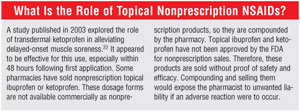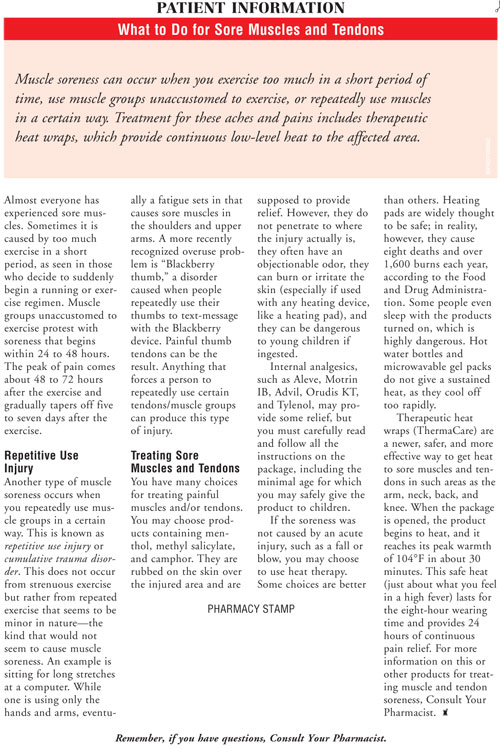US
Pharm. 2006;5:18-24.
Muscle/tendon soreness affects
virtually everyone, regardless if the patient is a serious athlete or engages
in exercise on an intermittent, recreational basis. The widespread nature of
muscle soreness is due partly to the various activities that produce it.
Muscle soreness is a response to sports, exercise, work, travel, or daily
activities.
Effects of Exercise
Exercise that leads
to muscle soreness and pain causes increases in muscle enzymes in the
bloodstream, inflammation, and structural damage.1 These coexist
with a decrease in the patient's range of motion and strength in the affected
area(s).
The Role of Eccentric
Muscle Contractions
Exercise is thought
to induce microtears in the muscle, leading to muscular soreness and fatigue.
1 Significant research on muscle soreness has focused on eccentric
muscle contractions. During this type of muscular movement, muscles lengthen,
which causes the microtears characteristic of exercise-induced muscle damage.
2 This occurs because of simple physics: If a stretched muscle is
subjected to a given load, the abnormally lengthened fibers undergo increased
tension, compared to the same muscle in the unstretched state, and the same
number of muscle fibers must endure an increased load-to-fiber ratio.2
This also explains why muscle motions that are isometric, shortening, or
concentric do not induce fatigue as readily.
Injurious Types of Exercise
Some exercises are
more damaging to muscle than others. For instance, downhill running, hiking,
descending stairs, and lowering weights are all eccentric in nature, causing a
greater incidence of muscle soreness.1,2 By contrast, cycling does
not involve eccentric motions and is less prone to lead to muscle soreness.
Characteristics of Muscle
Soreness
Muscle soreness
occurs at the highest level about 24 to 48 hours after injurious exercise,
reaching a peak within 48 to 72 hours, and disappearing five to seven days
after the exercise.2 Inflammation also increases, to reach its peak
a few days after the exercise. Interestingly, the first bout of exercise is
most likely to produce soreness. If the patient engages in the same exercise a
second time, the phenomenon of adaptation ensures less muscle soreness and a
more rapid recovery of full strength.2 Adaptation can provide
protection for as long as six months.
Treating Muscle Soreness
Pharmacists can
recommend radically differing modalities to treat muscle soreness, including
external and internal analgesics, as well as application of heating devices
and constant low-level heat therapy via therapeutic heat wraps.
External Analgesics:
Most external analgesics (e.g., benzocaine, pramoxine, hydrocortisone) are
not indicated for muscle soreness. Those that have this indication are known
as counterirritants. While they have been used for decades, their
efficacy is limited for many reasons.
Counterirritants are placed
into four distinct categories, depending on the action they have when applied
topically.3 The first category includes capsaicin and capsicum--two
ingredients seldom incorporated into muscle soreness products. Rather, these
ingredients are primary components of "pepper" creams, such as Zostrix and
Capzasin, which are mainly used for postherpetic neuralgia.
Methyl nicotinate is an
example from another category of external analgesics: those that directly
dilate superficial vessels. This ingredient is rarely included in the formulas
of external analgesic combinations. As a vasodilator, it has the remote
possibility of causing fainting if it is applied over large sections of the
body.
A third group of external
analgesics produces cooling upon initial application; yet, with continued
friction or rubbing, the cooling changes to warmth. This group includes
camphor and menthol.
A final group produces
redness, irritation, and warmth upon initial application, with the warmth
intensifying if the patient continues to apply friction to the site of
application. The most common muscle soreness ingredient from this group is
methyl salicylate. Topical application can lead to systemic absorption; thus,
the patient should be given traditional salicylate use precautions and drug
interaction warnings.4,5
A major limitation to
counterirritant use is their superficial action. If the patient's muscles are
sore, an ideal therapy would penetrate to the muscle to provide relief.
However, during the FDA OTC Review, the panel exploring the utility of
counterirritants reject ed claims that counterirritants penetrate skin to
enter muscles or joints.3 Their action is compared to scratching an
itch, as they help mask the underlying discomfort. External analgesics should
not be used in patients younger than 2 years, nor should they be used for more
than seven days. Use in conjunction with a heating pad, hot water bottle, heat
lamp, or heated gel pack can cause severe burns and is not recommended. Most
counter irritants, especially methyl salicylate and camphor, have an odor
that many patients find highly objectionable. Counterirritants have also been
implicated in contact dermatitis, dermal absorption of active ingredients,
toxicity/death upon accidental or intentional ingestion, and fetal problems in
pregnant patients.6-11

External Products of Unknown Efficacy: Despite a lack of evidence, emu oil continues to be touted as a remedy for sore muscles and is linked with several other unproven claims. Some marketers of the "blue" ointments and creams (e.g., Blue Stuff) add menthol or other proven counterirritants. Any perceived benefit would probably be no greater than that expected from the counterirritant alone. Similarly, trolamine (also known as triethanolamine salicylate, as found in Aspercreme, Sportscreme, Mobisyl, and Myoflex) has been promoted for years for relief of muscle soreness. However, external analgesic documents provided by the FDA on its Web site shows that trolamine has not been proved safe or effective for this use.12
Internal Analgesics: Internal analgesics (e.g., Aleve, Advil, Motrin IB, Orudis KT, Tylenol) can relieve muscular aches and pains and are safe if all label directions are followed. The pharmacist can urge patients to adhere to the age limitations indicated on the containers of these products, although companies publish dosing charts for certain products (e.g., Tylenol) which purport to indicate safe doses for pain in newborns and children under age 2. These dosage charts are of questionable legality, as the doses are not FDA approved to be shown on the product labels.
Internal Products of Unknown
Efficacy:
Glucosamine/chondroitin and S-adenosylmethionine (SAMe) are also widely
promoted for muscle problems, but without sufficient supporting evidence. As
dietary supplements, they evade the FDA requirements for research to prove
safety and efficacy through the 1994 Dietary Supplement Health and Education
Act. Oral homeopathic arnica 30x was investigated for muscle soreness and was
found to be ineffective.13 The pharmacist should be careful in
recommending these products.
Cryotherapy vs.
Thermotherapy:
Regarding acute injuries, traditional treatment has five components, referred
to as PRICE: protection, rest, ice, compression, and elevation. Cold therapy
(cryotherapy) is valuable in limiting the extent of injury and reducing the
time needed in rehabilitation. Yet, after 24 to 72 hours, cryotherapy is of
little efficacy; thermo therapy may be instituted. Cryotherapy also has
little efficacy for non acute muscle problems, such as muscle soreness and
repetitive use syndromes. In these cases, thermotherapy can provide relief.
Pharmacists have been able to
recommend such thermotherapy devices as hot water bottles, microwavable gel
packs, exothermic crystalline cascade liquids (e.g., Zap Pac), and heating
pads. Each has disadvantages. None of them allow the wearer to engage in work
or sports, since they cannot be secured to the body. Heating pads require
continual access to electricity, which restricts patient mobility, even around
the house. None can achieve and maintain a constant heat level. Hot water
bottles must be refilled, while gel packs must be rewarmed. Crystalline
cascade products require reboiling and subsequent cooling before they can be
reused. Heating pads utilize a thermostat that does not allow them to maintain
a constant heat level. Heating pads can also cause burns, even on the
low-power setting.14-18
The advent of therapeutic heat
wraps (e.g., ThermaCare) has revolutionized thermotherapy.19 They
reduce pain and disability in patients with acute and subacute low back pain.
20 After the package is opened, an innovative set of discs containing
iron begins to oxidize, producing a low-level heat of 104°F. This
low-level heat is far safer than that obtained with heating pads. It also
maintains the heat at a constant temperature over the eight-hour wearing time,
which no other nonprescription modality can currently achieve. The devices can
also be worn during work or recreational activities, so that the patient has
an uninterrupted session of therapy. Finally, after the eight-hour wearing
time, the patient experiences sustained relief for a full 24 hours. Patients
can sleep with therapeutic heat wrap devices in place, a practice that the
Consumer Product Safety Commission and FDA cautioned against at any time with
heating pads because of the substantial risk of burns.17,18,21
Pregnant patients and those with diabetes, rheumatoid arthritis, poor
circulation, or heart disease (e.g., hypertension) should consult a physician
before using therapeutic heat wraps. Patients ages 55 and older should wear
heat wraps over a thin layer of clothing to reduce the risk of a burn.

REFERENCES
1. Clarkson PM,
Newham DJ. Associations between muscle soreness, damage, and fatigue. Adv
Exp Med Biol. 1995;384:457-469.
2. Clarkson PM, Hubal
MJ. Exercise-induced muscle damage in humans. Am J Phys Med Rehabil.
2002;81(11 suppl):S52-S69.
3. External analgesic
drug products for over-the-counter human use; establishment of a monograph and
notice of proposed rulemaking. Fed Reg. 1979;44:69768-69866.
4. Bell AJ, Duggin G.
Acute methyl salicylate toxicity complicating herbal skin treatment for
psoriasis. Emerg Med. 2002;14:188-190.
5. Martin D, Valdez J,
Boren J, Mayersohn M. Dermal absorption of camphor, menthol, and methyl
salicylate in humans. J Clin Pharmacol. 2004;44:1151-1157.
6. Oiso N, Fukai K,
Ishii M. Allergic contact dermatitis due to methyl salicylate in a compress.
Contact Dermatitis. 2004;51:34-35.
7. Torloni MR, Cordioli
E, Zamith MM, et al. Reversible constriction of the fetal ductus arteriosus
after maternal use of topical diclofenac and methyl salicylate. Ultrasound
Obstet Gynecol. 2006;27:227-229.
8. Matteucci MJ. One
pill can kill: assessing the potential for fatal poisonings in children.
Pediatr Ann. 2005;34:964-968.
9. Chan TY. Ingestion
of medicated oils by adults: the risk of severe salicylate poisoning is
related to the packaging of these products. Hum Exp Toxicol.
2002;21:171-174.
10. Gouin S, Patel H.
Unusual cause of seizure. Pediatr Emerg Care. 1996;12:298-300.
11. Love JN, Sammon M,
Smereck J. Are one or two dangerous? Camphor exposure in toddlers. J Emerg
Med. 2004;27:49-54.
12. Rulemaking history
for OTC external analgesic drug products. Available at:
www.fda.gov/cder/otcmonographs/External_Analgesic/new_external_analgesic.htm.
Accessed March 30, 2006.
13. Vickers AJ, Fisher
P, Smith C, et al. Homeopathic arnica 30x is ineffective for muscle soreness
after long-distance running: a randomized, double-blind, placebo-controlled
trial. Clin J Pain. 1998;14:227-231.
14. Diller KR. Analysis
of burns caused by long-term exposure to a heating pad. J Burn Care Rehabil
. 1991;12:214-217.
15. Ozgenel Ege GY,
Ozcan M. Heating-pad burn as a complication of abdominoplasty. Br J Plast
Surg. 2003;56:52-53.
16. Ferlo Todd J.
Heating devices: how to avoid burns. Available at:
www.fda.gov/cdrh/medicaldevicesafety/
tipsarticles/nj/1097.pdf. Accessed
March 30, 2006.
17. Rudick JM. Public
health advisory on electric heating pads prompted by MDR reports. Available
at: www.fda.gov/cdrh/fuse16.pdf. Accessed March 30, 2006.
18. Burlington DB,
Brown A. FDA/CPSC public health advisory: hazards associated with the use of
electric heating pads. Available at: origin.www.fda.gov/cdrh/heatpad.pdf.
Accessed March 30, 2006.
19. Michlovitz S, Hun
L, Erasala GN, et al. Continuous low-level heat wrap therapy is effective for
treating wrist pain. Arch Phys Med Rehabil. 2004;85:1409-1416.
20. French SD, Cameron
M, Walker BF, et al. Superficial heat or cold for low back pain. Cochrane
Database Syst Rev. 2006;(1):CD004750.
21. ThermaCare. Coming
soon! Available at: www.thermacare.com/en_CA/index.jsp. Accessed March 30,
2006.
22. Cannavino CR,
Abrams J, Palinkas LA, et al. Efficacy of transdermal ketoprofen for delayed
onset muscle soreness. Clin J Sport Med. 2003;13:200-208.
To comment on this article,
contact
editor@uspharmacist.com.






